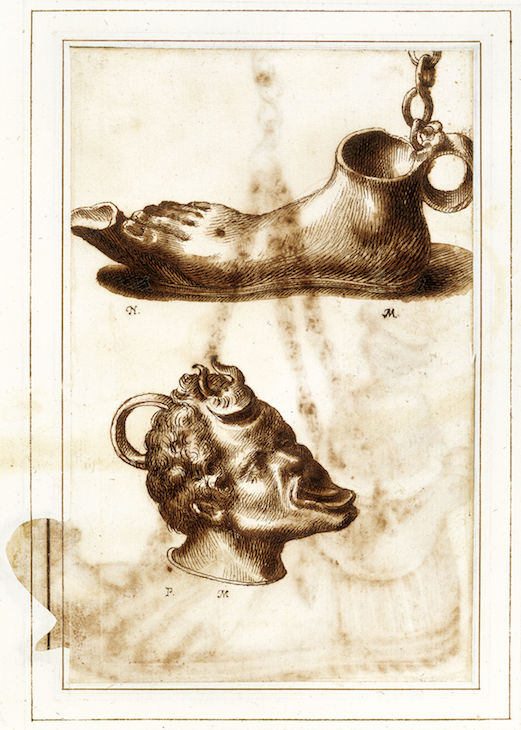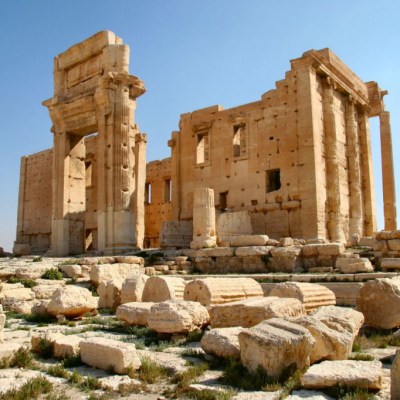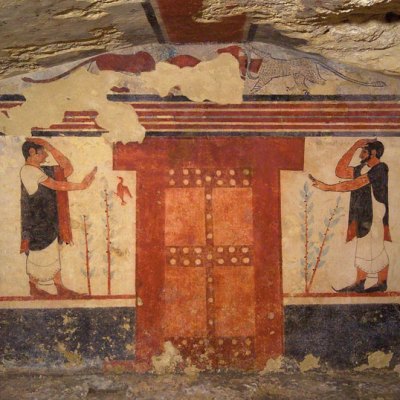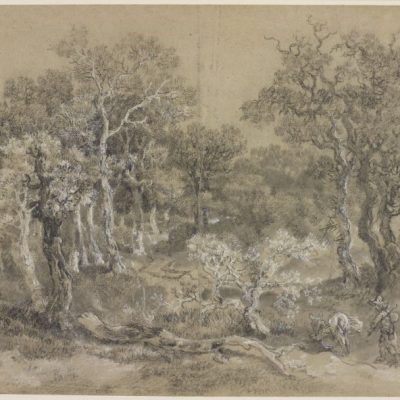When John Evelyn and Thomas Henshaw explored Rome in November 1644 they, like many before and after them, were pointed to the rooms of the Jesuit Father Athanasius Kircher, which were ‘full of admirable curiosities and experiences both mathematicall, magneticall, and hydraulick’. Among their other visits in these busy days was a call upon a more sophisticated and distinctly better-ordered collection, the Museo Cartaceo, a paper museum, still being assembled by Cassiano dal Pozzo. An intellectual and patron of Poussin among others, he was impeccably well connected, from papal circles onwards. His ambition was to capture the full range of res humanae and res divinae on the page, commissioning skilled draughtsmen to assemble hundreds of drawings showing, as he put it, ‘everything good that I have seen in marble and bronze which can provide some information about antiquity’.
Various architectural elements and sculptures, from the Antichità Diverse album (fol. 108v) (16th century), Italian. Royal Library, Windsor; © HM Queen Elizabeth II 2017

Evelyn was struck by Cassiano’s ‘rare collection’ of antique Roman bas reliefs, coins, medals and some intriguing fossils, or ‘petrified timber’, one piece of which he mentions in his book Sylva as having been sent by Cassiano to Sir George Ent FRS for examination. Cassiano’s investigation of natural history attracted visiting botanists such as John Ray and Philip Skippon. The pair described accurately the nature of what they were shown at the Palazzo dal Pozzo in 1665, closely following the order of the Antichità Diverse album now in the Royal Collection at Windsor.
For early Fellows of the Royal Society such as Evelyn, Henshaw, Ray, and Skippon, these vivid, first-hand experiences on their Grand Tour were formative, enshrining the Royal Society motto, chosen by Evelyn, Nullius in Verba (Take nobody’s word for it). Eager visitors were shown into the cavaliere’s palazzo on Via dei Chiavari where they could spend time admiring innumerable copies of items as varied as lead piping, strigils or milestones, as well as ‘all the instruments used in sacrifices’ recorded by Ray and Skippon. Cassiano’s museum viewed the ancient world through the perspective of its functional, ritual and ornamental items, a rounded understanding that prefigured the examination of sites such as Pompeii and Herculaneum almost a century later.
Etruscan bronze mirror, from the Antichità Diverse album (fol. 30v) (17th century), Italian. Royal Library, Windsor; © HM Queen Elizabeth II 2017

The drawings in this album – 176 plates, each meticulously catalogued – almost all appear to have been made in the 1620s by two artists. The majority of one series are small antiquities drawn from life, and most of the other group are copies of copies taken from sources such as the Codex Ursinianus in the Vatican Library. Cassiano’s endeavour was not the first attempt to encapsulate knowledge in this way, but he was more systematic and wide-ranging than his predecessors. He was immensely well connected, with access to the circles of the Medici and Borghese, to high-ranking churchmen and to the nascent learned institutions of Rome. Cassiano played a key role in the first of all scientific societies, the Accademia dei Lincei in Rome, founded 60 years before the Royal Society.
By the mid 1620s, that intellectual titan Nicolas-Claude Fabri de Peiresc was enquiring how Cassiano’s project was progressing; the two men met soon after, on the strength of which Peiresc introduced him to Rubens who, he hoped, might find him a suitably skilled engraver for the intended publication. As exemplified by this exchange, the so-called Republic of Letters, facilitated by links between papal and aristocratic circles, was a trans-European network and astonishingly effective and fertile through the contacts between its key figures. Cassiano regularly presented some of his finest drawings to those who might help the enterprise, and although the notion of publishing a full series of engravings based on the drawings would quickly fade, the steady exchange of information, antiquities, casts and drawings continued within this circle and its immediate outliers. Some engravings were made, with the authority of Cassiano and his brother Carlo Antonio, but never as the full record of the ever expanding Museo Cartaceo.
Pottery burial urn and its contents, from the Antichità Diverse album (fol. 18v) (17th century), Italian. Royal Library, Windsor; © HM Queen Elizabeth II 2017

This handsome edition, only one album within the many folios, volumes and other works on paper within Cassiano’s enterprise, is an immense undertaking of impeccable scholarship and, I surmise, many years in the making. It includes an introduction from the late Francis Haskell with Henrietta McBurney; the editors then proceed to discuss the various ‘hands’, attempts to elucidate the order of the folios, to provide accurate dates and to verify sources. Once the Museo existed it also became, in its own right, an invaluable source, adding to the complicated picture of origins and provenance of items. In its entirety it accurately reflected the state of antiquarian and archaeological knowledge of the time, and as such was shot through with forgeries and pastiches, or items innocently restored in ignorance, to become inadvertently misleading to future generations. The scholars involved are frequently foxed or faced with difficulties of interpretation. As Amanda Claridge and Elena Vaiani end their introductory sections: ‘In its own special way, the Antichità Diverse is a reminder of older dialogues, and of how much we have yet to learn.’
After Cassiano’s death in 1657, his family toyed with expanding and reorganising the paper museum but it was essentially still the collection that Evelyn had seen. In 1703 it was sold to Pope Clement XI and then in 1714 passed to his cardinal nipote. In 1762 almost the entire Albani collection was purchased for George III through the agency of James Adam, except for the botanical albums that later found their way to Paris, and the Institut de France, in 1798. But as time passed, and the number of intermediaries increased, there was considerable slippage, including more than 800 architectural drawings bought by Sir John Soane at the Adam sale in 1818 (these are already published). Other volumes were separated from the main corpus in the Royal Collection when George III’s library was given to the British Museum in 1823 (astonishingly, some not to be ‘rediscovered’ until the 1980s) and the process of attrition even extended to the Royal Library, which just after the First World War saw the dispersal of around 15 volumes. Finally the Stirling-Maxwell sale of more than 300 drawings was auctioned, and broken up, as recently as 1990.
Two bronze lamps in the dal Pozzo and Poussin (?) collections, from the Antichità Diverse album (fol. 64v) (17th century), Italian. Royal Library Windsor; © HM Queen Elizabeth II 2017

And still drawings and prints continue to emerge, sometimes returning to the Royal Collection. Cassiano dal Pozzo’s extraordinary endeavour to encapsulate the knowledge of his time is intriguing on many levels. The publication of the Antichità Diverse album is a crowning achievement, but it is by no means the last word.
The Antichità Diverse Album: The Paper Museum of Cassiano dal Pozzo, by Elena Vaiani and Amanda Claridge (eds.), is published by Harvey Miller Publishers (€130).
From the October 2017 issue of Apollo. Preview and subscribe here.



